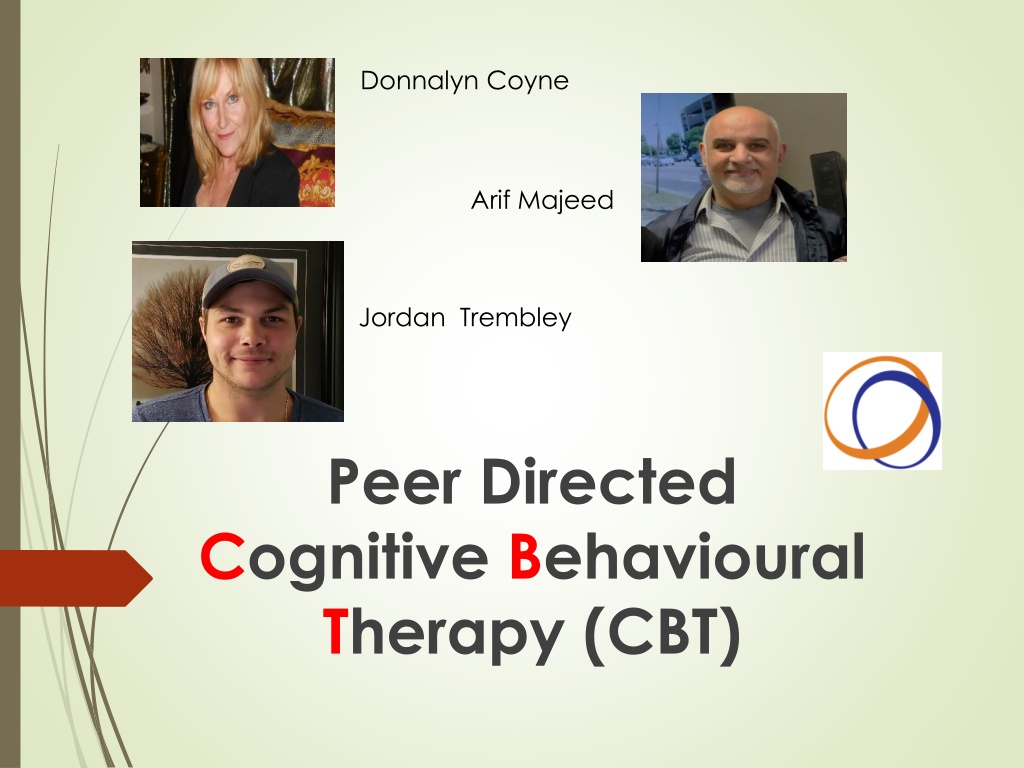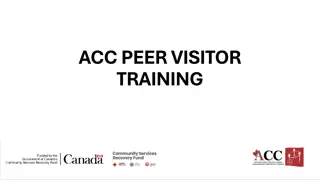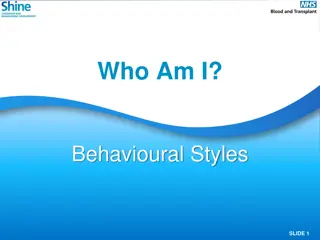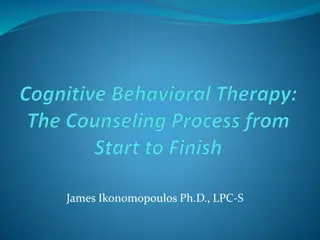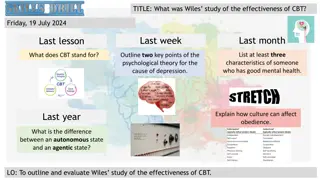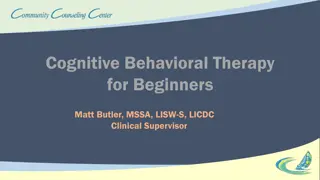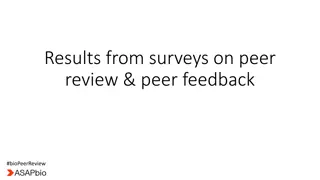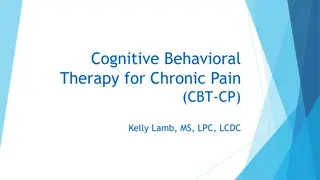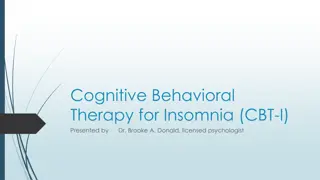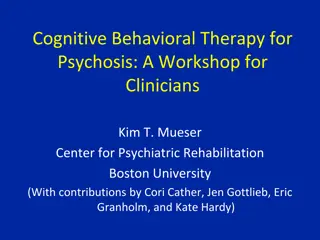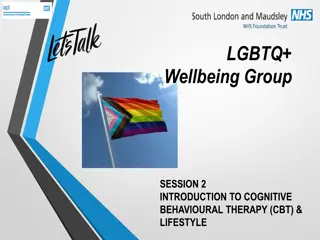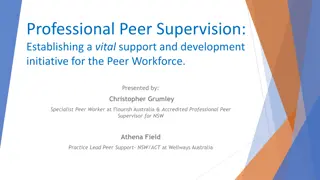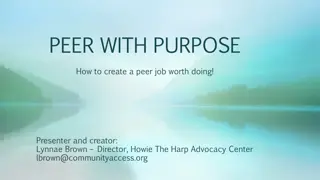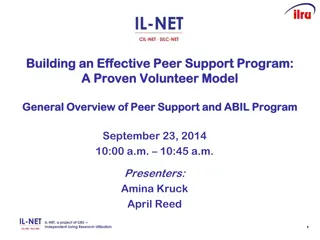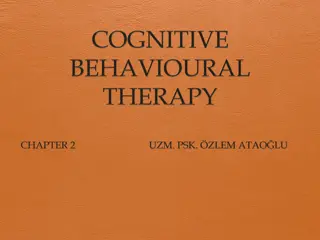Peer-Directed Cognitive Behavioural Therapy (CBT) Workshop Information
Explore the Peer-Directed Cognitive Behavioural Therapy workshop content covering agreements, comfort rules, CBT explanation, managing thoughts and emotions, common thinking traps, and cognitive distortions. Learn about the importance of distinguishing thoughts from feelings and strategies to challenge unhelpful thinking patterns.
Download Presentation

Please find below an Image/Link to download the presentation.
The content on the website is provided AS IS for your information and personal use only. It may not be sold, licensed, or shared on other websites without obtaining consent from the author. Download presentation by click this link. If you encounter any issues during the download, it is possible that the publisher has removed the file from their server.
E N D
Presentation Transcript
Donnalyn Coyne Arif Majeed Jordan Trembley Peer Directed Cognitive Behavioural Therapy (CBT)
Agreements and Statements 2 Personal bill of rights Privacy and confidentiality policy Confidentiality agreement
Comfort Agreement. 3 Switch off mobile devices Respect Dignity Non-Judgmental No cross talk Confidentiality Try to hear what others have to say Respect others gender identity/ pronouns Self care
4 What is Cognitive Behavioural Therapy? Photo: Stansfield, A. (n.d.). How is this different to Cognitive Behavioural Therapy? Retrieved from http://in8.uk.com
Thoughts are not Feelings 5 It is important to remember thoughts are NOT feelings They can be easily confused . The same situation can be interpreted in different ways. For example, you are shopping at the supermarket. You are checking the eggs and the carton slips out of your hands. All of the eggs fall out of the carton some rolling, others breaking. What thoughts would lead you to feel embarrassed? What thoughts would lead you to feel indifferent? What thoughts would lead you to feel amused?
Thinking Traps There are a number of unhelpful self-statements or thoughts that precede a distressing emotion. 6 There are common patterns to these thoughts called thinking traps We will go through some common thinking traps. Pay attention to the ones you commonly use.
Mental Filter 7 What is it? This thinking involves looking at the negative parts of a situation and ignoring the positive parts of the situation Example You have a lovely evening out with your partner. At the end of the evening, you have a disagreement over the tip. You end up only thinking about the disagreement Strategies Keep a gratitude journal helps shift your mind towards savoring the positives Remember the facts of the whole picture
Jumping to Conclusions / Mindreading 8 What is it? We assume we know what someone else is thinking and we make predictions about what is going to happen in the future Example: You are talking to someone and during the conversation they look at their watch. Perhaps you ve thought They must think I am a really boring person . Strategy: Look at the evidence. What evidence is there to support your conclusion? What is a more balanced, helpful way to look at things
Personalization 9 What is it? Taking 100% responsibility for events that go wrong that you may not be responsible for or only partly responsible for. This style of thinking rarely considers external factors that may be responsible for the event. Example: The toast burned at breakfast and you blame yourself not the toaster. Strategy: Make a responsibility pie chart. Notice what other external factors may be responsible. Break down the situation and you will see you most likely were only partially responsible
Catastrophizing 10 What is it? Assuming the worst-case scenario will happen, blowing things out of proportion, even when the problem is relatively small Example: I have chest pain. I must be having a heart attack Strategies: Focus on the evidence or facts of the event, not imaginary consequences Ask yourself, what is a more balanced, realistic way of viewing the situation?
11 Black and White Thinking What is it? Seeing only one extreme or the other. You are either right or wrong, good or bad, and so on. Example: There is only one winner and the rest are losers Strategy: Ask yourself, where are the shades of grey in this?
12 Should-ing and Must-ing What is it? At times, by saying I should or I must you can put unreasonable demands on yourself and others Example I should always get things right. She should know better than that. Strategy Try to change your language from I should to I would like to Catch yourself when you are should-ing and ask yourself is this reasonable?
Overgeneralization 13 What is it? Taking one instance in the here and now and imposing it on all future situations. Often includes all , never , always etc. Example: Things never turn out well for me. This is just so typical . Strategy: Catch yourself using extreme words such as all, never, always, every and change those words to be more specific to the situation this time , right now , sometimes etc.
Labelling What is it? We label ourselves when we make global statements based on behaviour in specific situations Example: I am stupid . I am not pretty . They are so inconsiderate . Strategy: Focus on the specific behaviour or event rather than making a statement about the person as a whole. For example, it was inconsiderate of him to leave the house a mess rather than he is inconsiderate. 14
Emotional Reasoning 15 What is it? You base conclusions based on how you are feeling. In other words, you feel anxious so you think something bad is going to happen. Example: I feel so depressed. This must be the worst place to work in. Strategy: Feelings are not facts! They are feelings. They come and they go. Look to the evidence and facts of the situation rather than be guided by how you feel.
16 Magnification and Minimization What is it? You enlarge the positive attributes of other people and shrink the positive attributes of yourself Example Oh that doesn t count. I just got lucky Strategies Give yourself credit! No really, give your self credit. Make a success journal and note the little successes you achieve daily
Relaxation 17 Progressive Muscle Relaxation This technique is to start from your toes and go all the way up to you head - tensing and releasing one muscle group at a time. When practicing it is important to: Differentiate between muscle groups. Learn how to both tense and relax muscle groups. Practice, practice, practice!
Relaxation 18 Deep Breathing The most important thing is to notice when you are holding your breath or are breathing too quickly or shallowly. Once you notice, try the following: Timed breathing breath in for 5 and out for 5 or in for 4, hold for 2 out for 6 Resistance breathing add resistance to the exhale by pursing lips, using your nose or using your tongue to restrict air flow Meditative breathing choose a phrase on the inhale (ex. peace) and one on the exhale (ex. love) Do whichever works for you, It becomes easier with practice!
10 Modules also include the following Topics! 1. 2. 3. 4. 5. 6. 7. 8. Self Compassion Assertiveness Behavioural Activeness Cycle of Depression Cycle of Anxiety Thought Development Fear Skill Developments
Mindfulness 20 https://www.youtube.com/watch?v=qzR62JJCMBQ https://www.youtube.com/watch?v=-2zdUXve6fQ https://www.youtube.com/watch?v=_iGWdUTifIQ
Next Step! 21 Participant Workbook Trainer Manual Contact- LERN Experienced PDCBT Facilitator to train your Trainee Certification for Trainee Facilitator available for on-going Support How we Contact each other! Please contact Arif Majeed at 705-494-4774 ext. 225 Or e-mail: arif.majeed@pepplace.org
Testimonials This group has taught me show much. I learned lots from my facilitators I attended the PDCBT program held at People for Equal Partnership in Mental Health. I learned so many new skills that were practical and enjoyable to apply to every day life. PDCBT helped me recognize my thinking patterns and how to manage my thoughts when things become negative. I learned so much about myself and I feel this group will help me continue to grow. Our instructor was helpful, honest and inspiring. She always encouraged us to have self acceptance and helped me realize I'm never alone. This PDCBT program is certainly the most helpful tool I have used throughout my years of trying to cope with my mental health. So happy I got to be a part of this group and I would recommend it to anyone and everyone . 22 I love how we are all given lots of time to share and do the practical assignments. It helps to talk about things that I normally wouldn t. It also is so healing hearing others struggles and successes I love and enjoyed observing transformation in some of the participants
Arif Majeed Jordan Trembley Donnalyn Coyne 24
